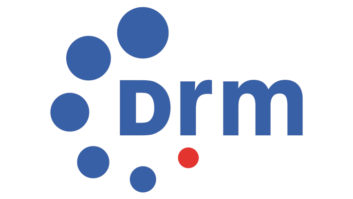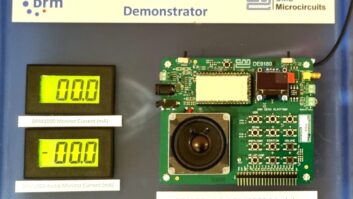The History of Digital Radio Mondiale and How It Compares to HD Radio and Eureka-147
This is the first in a two-part special series on the development of the Digital Radio Mondiale technology. The author explores its history and how the technology is similar to, and different from, that of Eureka-147 and HD Radio, starting with the current world environment for digital radio.
(click thumbnail)VT Merlin Engineer James Briggs and visiting freelance broadcast engineer Martin Spencer examine the DRM receiver mounted in the trunk of a promotional vehicle.
While U.S. broadcasters are focused on a form of digital radio that allows simultaneous analog and digital transmissions, Europe and other parts of the world prefer a digital-only approach.
Eureka — 147 is intended as an all — digital replacement for analog FM. Now Digital Radio Mondiale has been introduced as a digital radio system for the bands below 30 MHz.
There’s little doubt in some people’s minds that the future of broadcast radio is digital. Many industry figures would agree that standards are good for promoting the speedy take-up of new technology. So why aren’t the United States and Europe, two of the main players in this drama, taking the same route to making digital radio a reality?
While the U.S. radio industry has been moving towards the adoption of Ibiquity’s HD Radio as the digital replacement for AM and FM, alternative technologies dominate elsewhere. For several years, driven by developments begun in Europe, much of the rest of the world, including Canada, has begun implementing the Eureka-147 standard as a replacement for FM transmissions. South of the border, Mexico has carried out limited tests.
Differences
More recently, Digital Radio Mondiale, another system with European roots, has been launched to replace AM broadcasts on frequencies below 30 MHz.
In fact, there are good reasons for the existence of these various technologies; each has emerged as a result of differing approaches to radio that have evolved over the history of the medium. The development of radio broadcasting and the technical planning parameters used in its delivery are different on the two sides of the Atlantic Ocean.
Web Resources:Digital Radio Mondiale: www.drm.org
Eureka 147 DAB: www.worlddab.org
Ibiquity HD Radio: www.ibiquity.com
In particular see the White Papers section: “The Structure and Generation of Robust Waveforms for AM In-Band, On-Channel Digital Broadcasting” (Steven A. Johnson), and “The Structure and Generation of Robust Waveforms for FM In-Band, On-Channel Digital Broadcasting” (Paul J. Peyla).
Association of European Radios: www.aereurope.org
OLON (Netherlands): www.olon.nl
Commercial broadcasting, targeting population centers in particular, has dominated U.S. radio. European broadcasting, on the other hand, was founded on the principles of universal coverage and public service broadcasting, as developed by the U.K.’s BBC back in the 1920s, as related by Asa Briggs in “The History of Broadcasting in the United Kingdom,” published in 1961.
It was only in the second half of the 20th century that commercial broadcasting became firmly established across Europe where public service broadcasters, funded by various means, remain major players in almost every country. According to Annika Nyberg of the World DAB Forum, speaking at IBC in Amsterdam earlier this year, averaged out across Europe, public service broadcasters are still responsible for more than 50 percent of radio broadcasting there.
Technically, the frequencies used for domestic AM and FM broadcasting in the United States and Europe are broadly similar. (Europe, part of International Telecommunication Union Region 1, which also covers the former Soviet Union, the Middle East, China, Japan and Africa, has a slightly smaller AM medium — wave band and an additional AM long — wave band for very wide-area coverage.) However, despite the similarities, individual frequency allocations on AM and FM are planned rather differently.
Focusing on AM first, European planners operate with channels spaced at 9 kHz rather than 10 kHz apart. Moreover, allocations are made to first — adjacent — channel spacing; a station covering an adjacent area can be placed on an adjacent frequency. This would be highly unusual in the United States, where planners only allow stations in an adjacent area to be a minimum of two channels (20 kHz) away.
To avoid unwanted “splatter” affecting neighboring signals, European stations are limited in terms of audio bandwidth, with frequency roll-off starting at around just 5 kHz. Because audio performance is so limited in comparison with the United States, analog AM stereo was deemed a non-starter in Europe; it was tested but never received regulatory approval there.
FM broadcasting in most parts of Europe is younger than it is in the United States. The BBC began broadcasting on Band II FM frequencies (from 87.5 MHz to 108 MHz) as far back as the 1950s. However simulcasting of AM services was the norm until only about 20 years ago. That’s when demand for additional frequencies and better audio quality saw FM become popular in its own right.
In many European countries, much of the FM band is dominated by national networks, both commercial and public service, which typically occupy blocks of spectrum a little over 2.0 MHz wide in order to achieve wide-area, near-universal coverage. A typical network uses a grid of high — power transmitters interspersed with lower — power “fillers” or relays to solve reception problems caused by geographical features such as clusters of tall buildings, hilly or mountainous terrain.
Eureka is…
Large chunks of the FM band in Europe therefore are occupied by national and regional networks, the type of services for which Eureka-147 is designed. In many European countries, national networks have been simulcast via DAB for several years.
Because they use entirely separate frequencies outside the traditional broadcast bands, these digital transmissions can be continuous, operating around the clock. Today, as well as real-time rebroadcasting of existing analog services, new all-digital services for which space can’t be found on analog frequencies also are being launched.
A standard DAB multiplex can deliver no less than six high-quality digital networks (each at 256 kilobits per second), a larger number of services at a lower data rate or a combination of services at differing data rates, in just 1.5 MHz of spectrum.
However, for non-network, local services, spectrum efficiency is reduced because Eureka-147 frequencies carrying different program material cannot operate in areas adjacent to each other; mutual interference is the inevitable result. Different frequency blocks must be used, inevitably reducing spectral efficiency.
Because FM and DAB signals cannot be simulcast on the same frequencies, broadcasters and regulators needed to find new allocations for the Eureka-147 services. Current international allocations are in the old Band III TV band (174 to 240 MHz) and in the L-Band (at 1.4520 to 1.4920 GHz including some 12 MHz of satellite delivery spectrum).
Identifying and allocating these new frequencies took a great deal of time and certainly delayed the introduction of DAB services in some parts of Europe; moreover there are already concerns that current allocations are inadequate and that more spectrum will be needed in the near future.
More than two years ago, the Association of European Radios, a trade body representing the interests of private commercial broadcasters in France, Germany, Greece, Italy, Portugal, the Netherlands, Spain, Sweden and the United Kingdom, said, “Consideration should be given to the early release of additional spectrum where necessary.”
In the Netherlands, OLON, the organization that represents the interests of non-commercial, community-based broadcasters, published a report last year that looked at alternative approaches to implementing digital radio at the local level. This report, commissioned by the Directorate General of Telecommunications and Post in the Netherlands, was a response to problems encountered in finding sufficient spectrum to allow all local stations to begin DAB transmissions.
On short-, medium — and long — wave frequencies, the main problems to be solved by the introduction of digital transmission technology are improved resistance to interference and fading, better audio quality and the ability to operate single — frequency networks for the provision of wide — area services. Perhaps having learned from the difficulties encountered in finding new frequencies for DAB allocations, the DRM standard is a drop-in replacement for existing AM allocations. Simply convert the transmitter, drop the radiated power level slightly and a DRM service is ready to go.
A combination of operational and technical factors is behind the different implementations of digital radio found in the United States as compared to Europe. Having established what digital transmission technologies are intended to achieve, how then do the main contenders (DAB, DRM and HD Radio) work?
In fact, the underlying concepts of these three systems are similar. Each is based on spread-spectrum technology, originally developed for military communications and loosely related to that used in some wireless communications standards such as Bluetooth and the various 802.11 standards.
Broadcasters use a spread of multiple-carriers known as an Orthogonal Frequency Division Multiplex or Coded Orthogonal Frequency Division Multiplex to reduce the impact of frequency dependent, multi-path and signal degradation. Program information is spread across multiple carriers as well as being distributed across the time domain so that the effects of instantaneous interference also are minimized.
Before looking at the DRM system in detail, it’s worth examining the particular features that distinguish DAB and HD Radio a little further. Of all three systems, the Eureka — 147 DAB multiplex system has the greatest program data — carrying capacity, typically using 1,536 carriers spread over 1.5 MHz.
Multiplex capabilities
This program multiplex is dynamic, that is to say it can be configured “on-the-fly” to accommodate differing numbers of program services within the total data capacity available. For example, if a major news story or emergency occurs, two or three mono speech — based services could replace a high — quality stereo music service.
A Eureka — 147 DAB multiplex also can carry non — audio data, such as pictures and advanced Radio Broadcast Data Services-like information. Program services are merged into a single data stream, which is transmitted, then decoded by the receiver. All program services in a multiplex have the same geographical coverage.
The two HD Radio services have some similarities as well as differences. In its initial simulcast mode, AM HD Radio uses approximately 160 carriers, spread over three 10 kHz channels.
The FM version of HD Radio is more complex and in its simulcast mode can use up to approximately 1,100 carriers in two identically sized blocks of between 70 kHz and 97 kHz each, depending on mode employed, creating a maximum simulcast bandwidth of 400 kHz.
Although both are described as “in-band, on-channel” systems, it is clear that both the AM and FM systems rely on the use of “in-band, adjacent-channel” approaches to provide their simulcast (combined analog and digital) modes. Going back to the earlier explanation of differing planning standards, this is why AM HD Radio could not be used in its current form in Europe or other ITU Region 1 or 3 countries (everywhere outside the Americas).
Because of the planning criteria used in these ITU Regions, HD Radio simulcast modes in particular would cause serious interference to nearby services operating on adjacent channels. In the HD Radio system, digital energy is inserted into sidebands, radiated on adjacent channels. Because station allocations are packed closer in Europe than they are in the United States, this would cause interference problems if the same techniques were applied in Europe.
Broadly speaking, a similar problem would exist for FM HD Radio. FM planning in many parts of Europe relies on “interference limiting” beyond fringe areas of reception. Finding 400 kHz allocations (two adjacent FM stereo channels) that would not interfere with existing services would typically be almost impossible, particularly in larger urban areas.
The approach to how existing analog AM and FM transmissions are accommodated is therefore at the heart of the differences between HD Radio and DAB/DRM. HD Radio starts from the premise of beginning operations by simulcasting, transmitting both analog and digital signals within existing analog band plans, sharing individual channels with existing analog signals.
For the planning reasons discussed, this option is really a non-starter in ITU Regions 1 (Europe, Africa, the former Soviet Union, the Middle East, China and Japan) and ITU Region 3 (Asia and Australia). As a result, the DAB system and to a lesser extent the DRM system eschew this option. Instead, Eureka-147 DAB runs alongside established FM allocations but on completely different dedicated frequencies outside the traditional radio broadcasting bands.
The second part of this two-part story appears next issue.












